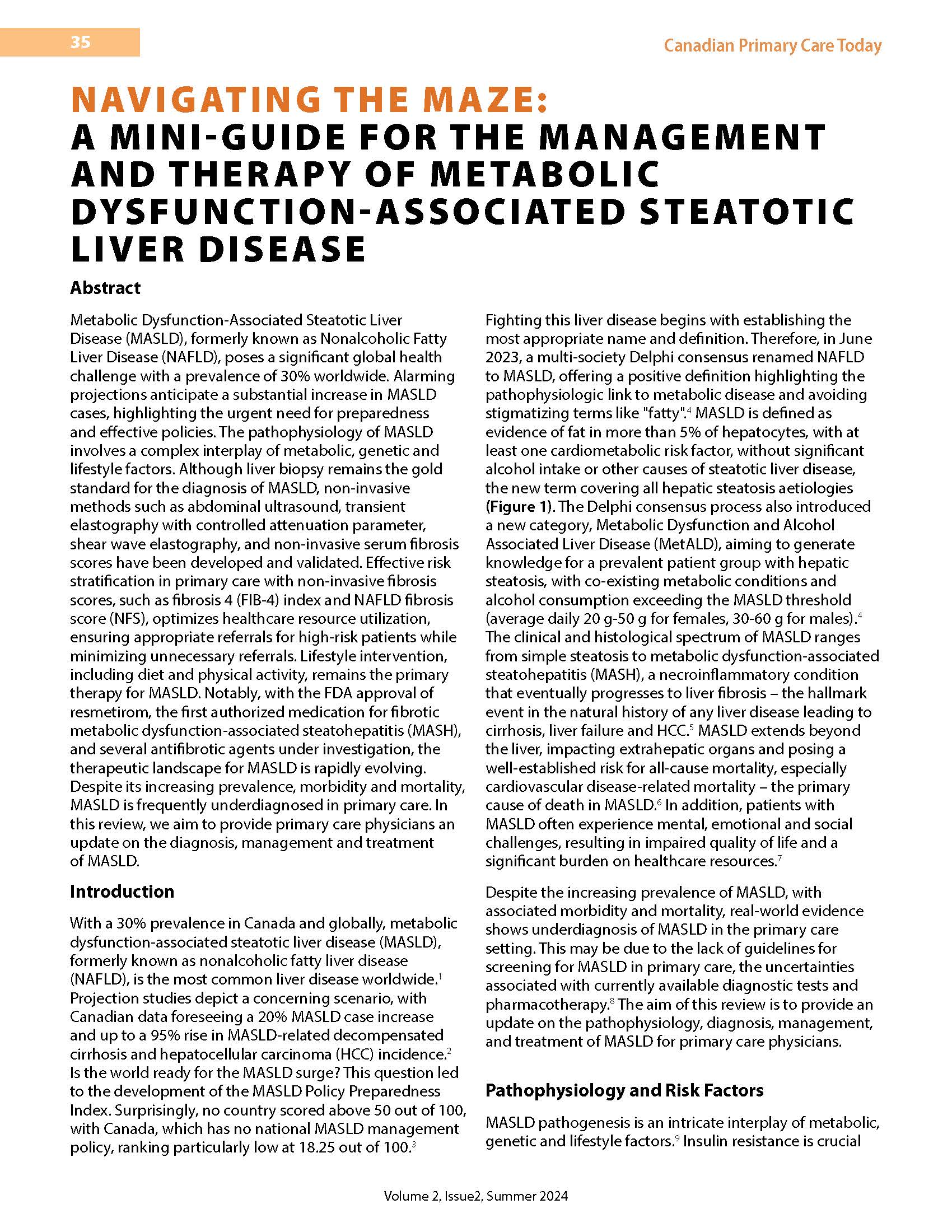Navigating the Maze: A Mini-Guide for the Management and Therapy of Metabolic Dysfunction-associated Steatotic Liver Disease
DOI:
https://doi.org/10.58931/cpct.2024.2232Abstract
Metabolic Dysfunction-Associated Steatotic Liver Disease (MASLD), formerly known as Nonalcoholic Fatty Liver Disease (NAFLD), poses a significant global health challenge with a prevalence of 30% worldwide. Alarming projections anticipate a substantial increase in MASLD cases, highlighting the urgent need for preparedness and effective policies. The pathophysiology of MASLD involves a complex interplay of metabolic, genetic and lifestyle factors. Although liver biopsy remains the gold standard for the diagnosis of MASLD, non-invasive methods such as abdominal ultrasound, transient elastography with controlled attenuation parameter, shear wave elastography, and non-invasive serum fibrosis scores have been developed and validated. Effective risk stratification in primary care with non-invasive fibrosis scores, such as fibrosis 4 (FIB-4) index and NAFLD fibrosis score (NFS), optimizes healthcare resource utilization, ensuring appropriate referrals for high-risk patients while minimizing unnecessary referrals. Lifestyle intervention, including diet and physical activity, remains the primary therapy for MASLD. Notably, with the FDA approval of resmetirom, the first authorized medication for fibrotic metabolic dysfunction-associated steatohepatitis (MASH), and several antifibrotic agents under investigation, the therapeutic landscape for MASLD is rapidly evolving. Despite its increasing prevalence, morbidity and mortality, MASLD is frequently underdiagnosed in primary care. In this review, we aim to provide primary care physicians an update on the diagnosis, management and treatment
of MASLD.
References
Younossi ZM, Golabi P, Paik JM et al. The global epidemiology of nonalcoholic fatty liver disease (NAFLD) and nonalcoholic steatohepatitis (NASH): a systematic review. Hepatol. 2023 Apr;77(4):1335–47. DOI: https://doi.org/10.1097/HEP.0000000000000004
Swain MG, Ramji A, Patel K et al. Burden of nonalcoholic fatty liver disease in Canada, 2019-2030: a modelling study. CMAJ Open. 2020;8(2):E429–36. DOI: https://doi.org/10.9778/cmajo.20190212
Lazarus JV, Mark HE, Villota-Rivas M et al. The global NAFLD policy review and preparedness index: Are countries ready to address this silent public health challenge? J Hepatol. 2022 Apr;76(4):771–80.
Rinella ME, Lazarus JV, Ratziu V et al. A multi-society Delphi consensus statement on new fatty liver disease nomenclature. Hepatol. 2023 Jun 24; DOI: https://doi.org/10.1097/HEP.0000000000000696
Rinella ME, Neuschwander-Tetri BA, Siddiqui MS et al. AASLD Practice Guidance on the clinical assessment and management of nonalcoholic fatty liver disease. Hepatology. 2023 May;77(5):1797–835. DOI: https://doi.org/10.1097/HEP.0000000000000323
Adams LA, Anstee QM, Tilg H et al. Non-alcoholic fatty liver disease and its relationship with cardiovascular disease and other extrahepatic diseases. Gut. 2017 Jun 1;66(6):1138–53. DOI: https://doi.org/10.1136/gutjnl-2017-313884
Allen AM, Van Houten HK, Sangaralingham LR et al. Healthcare cost and utilization in nonalcoholic fatty liver disease. Real-world data from a large US claims database. Hepatol. 2018 Dec;68(6):2230–8. DOI: https://doi.org/10.1002/hep.30094
Schreiner AD, Sattar N. Identifying patients with nonalcoholic fatty liver disease in primary care: how and for what benefit? J Clin Med. 2023 Jun 12;12(12):4001. DOI: https://doi.org/10.3390/jcm12124001
Tilg H, Adolph TE, Moschen AR. Multiple parallel hits hypothesis in nonalcoholic fatty liver disease: revisited after a decade. Hepatology. 2021 Feb;73(2):833–42. DOI: https://doi.org/10.1002/hep.31518
Bugianesi E, Moscatiello S, Ciaravella MF et al. Insulin resistance in nonalcoholic fatty liver disease. Curr Pharm Des. 16(17):1941–51. DOI: https://doi.org/10.2174/138161210791208875
Saponaro C, Sabatini S, Gaggini M et al. Adipose tissue dysfunction and visceral fat are associated with hepatic insulin resistance and severity of NASH even in lean individuals. Liver Int. 2022;42(11):2418–27. DOI: https://doi.org/10.1111/liv.15377
Hrncir T, Hrncirova L, Kverka M et al. Gut microbiota and NAFLD: pathogenetic mechanisms, microbiota signatures, and therapeutic interventions. Microorganisms. 2021 Apr 29;9(5):957. DOI: https://doi.org/10.3390/microorganisms9050957
Sharma D, Mandal P. NAFLD: genetics and its clinical implications. Clin Res Hepatol Gastroenterol. 2022 Nov;46(9):102003. DOI: https://doi.org/10.1016/j.clinre.2022.102003
Cinque F, Cespiati A, Lombardi R et al. Nutritional and lifestyle therapy for NAFLD in people with HIV. Nutrients. 2023 Apr 20;15(8):1990. DOI: https://doi.org/10.3390/nu15081990
Berzigotti A, Tsochatzis E, Boursier J et al. EASL clinical practice guidelines on non -invasive tests for evaluation of liver disease severity and prognosis – 2021 update. J Hepatol. 2021 Sep;75(3):659–89. DOI: https://doi.org/10.1016/j.jhep.2021.05.025
Dulai PS, Singh S, Patel J et al. Increased risk of mortality by fibrosis stage in non-alcoholic fatty liver disease: Systematic Review and Meta-analysis. Hepatol. 2017 May;65(5):1557–65. DOI: https://doi.org/10.1002/hep.29085
ElSayed NA, Aleppo G, Aroda VR et al. Comprehensive medical evaluation and assessment of comorbidities: standards of care in diabetes-2023. Diabetes Care. 2023 Jan 1;46(Suppl 1):S49–67. DOI: https://doi.org/10.2337/dc23-S004
Pugliese N, Plaz Torres MC, Petta S et al. Is there an ‘ideal’ diet for patients with NAFLD? Eur J Clin Invest [Internet]. 2022 Mar [cited 2023 Feb 4];52(3). Available from: https://onlinelibrary.wiley.com/doi/10.1111/eci.13659 DOI: https://doi.org/10.1111/eci.13659
Bull FC, Al-Ansari SS, Biddle S et al. World Health Organization 2020 guidelines on physical activity and sedentary behaviour. Br J Sports Med. 2020 Dec;54(24):1451–62. DOI: https://doi.org/10.1136/bjsports-2020-102955
Harrison SA, Bedossa P, Guy CD, Schattenberg JM, Loomba R, Taub R, et al. A Phase 3, Randomized, Controlled Trial of Resmetirom in NASH with Liver Fibrosis. N Engl J Med. 2024 Feb 8;390(6):497–509. DOI: https://doi.org/10.1056/NEJMoa2309000

Published
How to Cite
Issue
Section
License
Copyright (c) 2024 Canadian Primary Care Today

This work is licensed under a Creative Commons Attribution-NonCommercial-NoDerivatives 4.0 International License.
